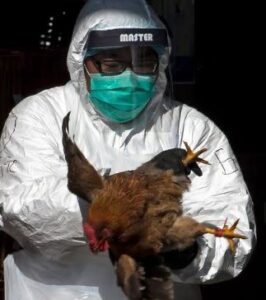
In a startling development, health officials recently confirmed the first-ever case of bird flu in a U.S. child. This case, which took place in California, highlights the ongoing threat of the H5N1 avian influenza virus. While the infection in the child was mild, it has raised concerns about how the virus spreads and whether it poses a significant risk to the public. In this article, we will delve into the details of this case, the broader bird flu situation, and what it means for the future.
What is Bird Flu?
Bird flu, also known as avian influenza, is a viral infection that mainly affects birds. The most concerning strain for humans is H5N1, which has caused several outbreaks in both poultry and wild birds around the world. The virus spreads when birds come into contact with infected droppings, saliva, or nasal secretions. Though the risk of bird flu spreading from animals to humans is rare, it can happen in cases where people have close contact with infected animals, such as poultry workers or those handling sick birds.
For humans, bird flu can cause a range of symptoms from mild flu-like illness to severe respiratory distress. The virus can be fatal if not treated promptly, but it is important to note that human-to-human transmission of H5N1 remains extremely rare.
The California Case: The First Confirmed U.S. Child Infection
In a recent report, the Centers for Disease Control and Prevention (CDC) confirmed that a child in California had been diagnosed with bird flu. This is the first known case of the infection in a U.S. minor. The child, who resides in Alameda County, had mild upper respiratory symptoms. These symptoms included a cough and sore throat, similar to those seen in typical flu cases. Fortunately, the child was treated with antiviral medications and is now recovering.
The child attends daycare, and health officials have suggested that the exposure may have been linked to wild birds. However, they have not ruled out other potential sources. While the case has raised concerns, it is important to note that the child’s symptoms were mild, and there has been no indication of human-to-human transmission.
How Did the Child Get Infected?
The exact cause of the child’s infection remains unclear. Health officials are investigating the possibility that the child came into contact with wild birds that were infected with H5N1. Wild birds are known to be major carriers of the virus, and they can spread it to other animals, including domesticated poultry.
It is worth noting that the child’s family members also showed mild symptoms, but none tested positive for the virus. Some of them tested positive for other common respiratory viruses, which suggests that the child’s illness could have been caused by a mix of factors. At this point, there is no evidence to suggest that the virus spread from the child to other members of the household.
Symptoms and Treatment of Bird Flu in Humans
Bird flu symptoms in humans can be similar to those of regular flu, but they may also include more severe respiratory issues. Common symptoms include cough, sore throat, fever, body aches, fatigue, and trouble breathing. In some cases, the virus can cause severe pneumonia or other life-threatening complications.
For the child in California, the symptoms were mild, and they responded well to antiviral treatment. The CDC and California Department of Public Health recommend that anyone who suspects they have bird flu seek medical attention immediately, as antiviral medications are most effective when given early in the course of illness.
The Spread of Bird Flu Among Animals
Bird flu has been spreading widely among wild birds, poultry, and other animals in the U.S. in recent years. The H5N1 strain has caused significant outbreaks in both commercial and backyard poultry farms. California has been particularly affected, with a large number of infected birds detected in the state.
In addition to poultry, the virus has also spread to other animals, including dairy cattle. Since March, there have been reports of dairy herds being infected with H5N1 in California, with over 400 herds testing positive for the virus. This makes California the epicenter of the bird flu outbreak in the U.S.
The State of Bird Flu in the U.S.
As of now, there have been 55 confirmed human cases of H5N1 bird flu in the U.S. this year, with 29 of those cases in California. Most of the individuals affected have been farmworkers or others who have had direct contact with infected birds. The vast majority of these cases have been mild, but health officials are concerned about the potential for the virus to spread more widely, particularly as the bird flu virus continues to affect animals in various regions.
Global Bird Flu Concerns
While the U.S. is currently experiencing its own bird flu outbreak, the virus is a global concern. Recently, a teenager in British Columbia, Canada, was hospitalized with bird flu after being exposed to infected animals. The teenager’s case highlights the international nature of the problem, as H5N1 continues to spread in wild birds and other animals worldwide.
In addition, experts are closely monitoring the virus for any signs of mutation that could make it more easily transmissible between humans. While this has not happened so far, the possibility of a more dangerous variant of H5N1 emerging remains a concern.
Also read: Netflix’s ‘A Man on the Inside’: #1 Crime Comedy You Can’t Miss
CDC’s Approach to Bird Flu in Humans
The CDC has been monitoring bird flu cases closely and working with state health officials to track potential outbreaks. Their approach involves identifying people who have had close contact with infected birds and monitoring them for symptoms. The CDC also provides guidelines on preventing exposure to the virus and ensuring that antiviral medications are available to those who need them.
How Are Health Officials Responding to This Case?
In response to the confirmed case in California, health officials are investigating how the child may have been exposed to the virus. The California Department of Public Health has been working with local agencies to determine the possible source of infection and to ensure that the public is informed of the risk.
So far, there is no indication that this case has spread to others in the community, but officials continue to monitor the situation closely.
The Risk to the Public
Despite the confirmed case in California, health experts maintain that the risk of a widespread bird flu outbreak is low. Human-to-human transmission of H5N1 has not been documented in over 15 years. Furthermore, the child’s symptoms were mild, and there is no evidence that the virus spread beyond the household.
Health officials continue to reassure the public that the risk of contracting bird flu remains low, especially for those who do not have close contact with infected birds or poultry.
What You Should Know About Preventing Bird Flu
If you live in an area where bird flu is present, there are several steps you can take to reduce your risk of infection. Avoid contact with sick or dead birds, especially if they appear to be affected by the virus. If you work with poultry or other animals, make sure to follow all safety guidelines to prevent exposure to the virus.
If you develop flu-like symptoms and have had recent exposure to birds, seek medical attention immediately. Early antiviral treatment can help reduce the severity of the illness.
Looking Ahead: Will the Bird Flu Become a Bigger Threat?
The situation with bird flu remains fluid, and health officials are keeping a close eye on potential developments. While the current risk to the public is considered low, the spread of the virus among animals and occasional human cases make it important to remain vigilant. Ongoing monitoring and prevention efforts will be key in keeping the virus from spreading further.
Also read: Retirement Home Crime Solved? Discover ‘A Man on the Inside’ Mystery
Conclusion
The confirmed case of bird flu in a California child is a reminder of the ongoing threat posed by the H5N1 virus. While the case was mild and there is no evidence of human-to-human transmission, it highlights the importance of monitoring the spread of the virus and taking precautions to prevent further infections. As always, the best defense against bird flu is awareness and early intervention.
FAQs
-
What is bird flu, and how does it spread?
- Bird flu is a viral infection that primarily affects birds but can occasionally spread to humans. It is most often transmitted through contact with infected birds or their droppings.
-
How common is bird flu in humans?
- Bird flu in humans is rare. Most human cases are linked to close contact with infected poultry or wild birds.
-
Should I be concerned if I live near a poultry farm?
- While the risk is low for the general public, those who work with poultry or have close contact with birds should take precautions to reduce their exposure.
-
What can I do to prevent bird flu infection?
- Avoid contact with sick or dead birds, and follow safety guidelines if you work with poultry. If you develop symptoms after exposure, seek medical treatment right away.
-
How are health officials preventing the spread of bird flu?
- Health officials monitor outbreaks, provide guidelines to prevent exposure, and ensure antiviral treatments are available for those who need them.


